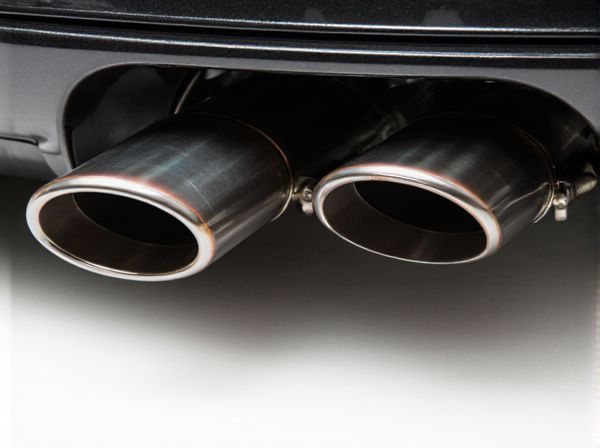
Photo illustration: Titanium vs Stainless steel
Titanium offers superior strength-to-weight ratio and exceptional corrosion resistance, making it ideal for aerospace and medical applications. Stainless steel provides excellent durability and is more cost-effective, commonly used in construction and kitchenware. Your choice depends on the need for lightweight performance or budget-friendly, robust material.
Table of Comparison
| Feature | Titanium Exhaust | Stainless Steel Exhaust |
|---|---|---|
| Weight | Lightweight (up to 40% lighter than stainless steel) | Heavier, adds more weight to vehicle |
| Durability | High corrosion resistance, lasts longer in harsh conditions | Good corrosion resistance, but prone to rust over time |
| Heat Resistance | Excellent heat tolerance, maintains strength at high temperatures | Good heat resistance but may discolor with prolonged heat |
| Cost | Expensive due to material and manufacturing complexity | Affordable and widely available |
| Sound Characteristics | Produces sharp, high-pitched exhaust note | Deeper, bass-rich sound |
| Maintenance | Low maintenance, resists corrosion and wear | May require regular cleaning to prevent rust |
| Common Use | High-performance sports and racing cars | Standard vehicles and aftermarket upgrades |
Introduction to Titanium vs Stainless Steel
Titanium and stainless steel are two widely used metals known for their strength, corrosion resistance, and durability in various industries. Titanium offers a higher strength-to-weight ratio and exceptional resistance to corrosion, especially in marine and aerospace applications, while stainless steel is prized for its affordability, versatility, and excellent resistance to oxidation and staining in everyday environments. Both materials serve critical roles in medical devices, construction, and manufacturing, with titanium favored for lightweight, high-performance needs and stainless steel chosen for cost-effective, robust solutions.
Composition and Material Properties
Titanium consists primarily of the element titanium, often alloyed with aluminum and vanadium, providing a high strength-to-weight ratio and superior corrosion resistance compared to stainless steel, which mainly contains iron, chromium, and nickel. Stainless steel alloys feature a higher density and excellent toughness, with chromium content forming a passive oxide layer that protects against rust and oxidation. Titanium exhibits lower thermal conductivity and greater biocompatibility, making it ideal for aerospace, medical implants, and marine applications, whereas stainless steel is favored for its cost-effectiveness and durability in construction and kitchenware.
Weight and Density Comparison
Titanium boasts a significantly lower density of approximately 4.5 g/cm3 compared to stainless steel's density of around 8.0 g/cm3, making it nearly 45% lighter. This weight advantage makes titanium ideal for applications where reducing mass is critical, such as aerospace and biomedical implants. Despite being lighter, titanium maintains exceptional strength and corrosion resistance, often surpassing stainless steel in strength-to-weight ratio.
Strength and Durability
Titanium exhibits a remarkable strength-to-weight ratio, making it significantly stronger and lighter than stainless steel, which benefits applications demanding high durability without added weight. Its corrosion resistance surpasses stainless steel, enhancing longevity in harsh environments such as marine or aerospace conditions. While stainless steel offers robust durability and cost-effectiveness for everyday use, titanium's superior strength and resistance to fatigue ensure long-term performance in extreme settings.
Corrosion and Rust Resistance
Titanium exhibits superior corrosion and rust resistance compared to stainless steel due to its ability to form a stable, protective oxide layer that prevents surface degradation even in harsh environments. Stainless steel, while corrosion-resistant from its chromium content, is prone to pitting and rust in chloride-rich conditions such as seawater. This makes titanium the preferred material in marine, chemical processing, and aerospace applications where long-term durability against corrosion is critical.
Biocompatibility and Health Considerations
Titanium exhibits superior biocompatibility compared to stainless steel, making it the preferred choice for medical implants and prosthetics due to its low allergenic potential and excellent corrosion resistance. Stainless steel can cause allergic reactions in sensitive individuals because of nickel content, and its susceptibility to corrosion poses risks in long-term medical applications. Titanium's ability to osseointegrate with bone enhances its health considerations by promoting stability and reducing inflammation in implant sites.
Thermal and Electrical Conductivity
Titanium exhibits significantly lower thermal conductivity, approximately 21.9 W/m*K, compared to stainless steel, which ranges around 16-25 W/m*K depending on the alloy grade. In terms of electrical conductivity, titanium conducts poorly, typically less than 1% of the conductivity of copper, whereas stainless steel shows moderate electrical conductivity, generally between 1.25 and 2.5 MS/m. These differences make stainless steel more suitable for applications requiring efficient heat and electrical transfer, while titanium excels in environments demanding lightweight and corrosion-resistant materials with limited heat conduction.
Cost and Availability
Titanium is significantly more expensive than stainless steel due to its complex extraction and processing requirements, which limits its widespread availability. Stainless steel is readily available and cost-effective, benefiting from established manufacturing infrastructure and abundant raw materials. The price difference makes stainless steel the preferred choice for large-scale applications where budget constraints are critical.
Common Applications and Uses
Titanium is widely used in aerospace, medical implants, and marine environments due to its high strength-to-weight ratio, corrosion resistance, and biocompatibility. Stainless steel is commonly applied in construction, kitchenware, automotive parts, and chemical processing equipment because of its durability, corrosion resistance, and cost-effectiveness. Both metals serve critical roles in industries requiring strength and resistance, with titanium favored for lightweight and high-performance applications and stainless steel preferred for structural and everyday uses.
Choosing Between Titanium and Stainless Steel
Choosing between titanium and stainless steel depends on factors such as strength, weight, corrosion resistance, and cost. Titanium offers superior strength-to-weight ratio and excellent corrosion resistance, making it ideal for aerospace, medical implants, and high-performance applications. Stainless steel provides greater affordability and durability for everyday use, along with good corrosion resistance suitable for kitchenware, construction, and automotive parts.
 caratoz.com
caratoz.com